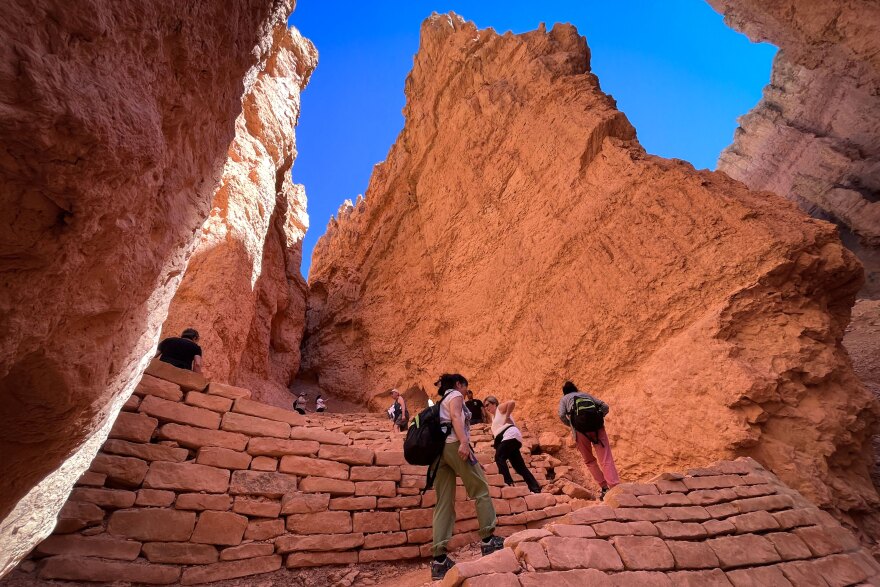Pueden encontrar la versión en español aquí.
__
After a couple of record-setting years, visitation at all of Utah’s national parks is down this summer.
The number of visitors at Bryce Canyon in June and July dropped 8% from 2024. Capitol Reef National Park faced a similar slump. At Glen Canyon National Recreation Area, there was a 20% decline.
In all, Utah’s five national parks and Glen Canyon saw a nearly 10% decrease compared to the year before.
That’s a big deal for nearby rural communities that rely on people coming to spend their money.
“There's no Silicon Slopes here,” said Lance Syrett, general manager of Ruby’s Inn hotel in Bryce Canyon City. “Tourism is king out here, and our economy lives and dies by tourism.”
People visiting Utah’s parks spent an estimated $1.9 billion in gateway communities in 2023, according to data from the National Park Service.
Even after cutting prices to chase customers, Syrett estimates revenue is down around 3% to 4% this summer at Ruby’s Inn, which his family has been running for more than a century.
“It's definitely a stressful time,” Syrett said. “Each year, you’ve got to make 2% or 3% more money just to keep up with inflation. So when you're down, that's not good.”
It’s especially painful in a place like Bryce Canyon, he said, because the high-elevation park has a relatively short peak season before the cold weather arrives, making it nearly impossible to make up the deficit later in the year.
The downturn at Utah’s parks is part of a broader travel trend this summer. It appears to be driven by a dip in international tourism, as months of economic uncertainty, on-again-off-again tariffs and political rhetoric coming from President Donald Trump lead some foreign travelers to think twice about coming to the U.S.
Falling border crossing numbers indicate fewer Canadians are taking road trips into the country. Mountain towns in Colorado have seen a slump in international guests, too.
In Las Vegas, year-over-year visitor numbers have declined for the past six months straight. That’s particularly relevant for southern Utah parks, because Vegas is a common airport destination where international tourists begin their red rock adventures.
“Everyone's down,” said Judy Franz, who directs the Page-Lake Powell Chamber of Commerce and the local visitor center. “When I see that the tour companies are down, that is a real indication to me that we've got an issue.”
Visitation in the Lake Powell area was down around 30% this July compared to last year, she said, fueled by that drop in international travellers. While people visiting from abroad typically outnumber American tourists, she said, that flipped in July.
Ruby’s Inn has seen the downturn in foreign visitors, too. In 2019, Syrett said roughly 60% of its guests came from abroad. After cratering during the pandemic, that number climbed back to around half by 2024. This year, it’s been just about 40%.
“Ruby's Inn wouldn't be what it is today without our international visitors,” he said. “It's such a big deal for us, and it’s been that way for a long time.”
The local tourism sector was built based on a certain number of foreign tourists coming each year, he said, and there’s just not enough Americans around to fill that gap.
Guests coming from abroad also tend to reserve rooms further in advance, which helps hotels plan their budgets and know how much they need to spend on advertising. This summer, he said the average booking at Ruby’s Inn has been made just two weeks in advance, compared to the six-week lead time the hotel had last year.
Despite the anxiety, Syrett said he’s hopeful the park tourism business will eventually bounce back like it has in the past.
“I lived through the ‘freedom fries’ and the French staying home,” he said, referring to the Iraq War era quarrel between the U.S. and its European ally. “I just hope that cooler heads prevail.”
While Franz acknowledges that economics and politics have both contributed to the downturn, other challenges have impacted Lake Powell, too.
The Dragon Bravo fire near Grand Canyon — now 64% contained — spewed smoke across the region for weeks. Headlines about the lake’s declining water levels also spurred some concerns among boaters, she said, even though a few launch ramps remain open.
“There's not just one thing,” Franz said. “I think it's a whole can of worms that we're facing.”
Extreme heat also may have kept some people away. Franz said her husband’s fishing guide business slowed down dramatically this summer because the hot weather made for a poor catch.
She’s encouraging local businesses to offer more discounts to entice visitors back, but with summer coming to a close, she said it’ll be hard to turn things around economically before 2026.
“These kinds of slowdowns, they're not just like an overnight thing, and then everything's going to pick right back up tomorrow,” Franz said. “But I think our businesses are all doing a really great job, trying to just keep their head above water.”
In the meantime, both Franz and Syrett said there’s one bright spot for Utahns: plenty of good deals available.






